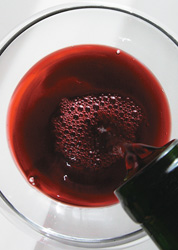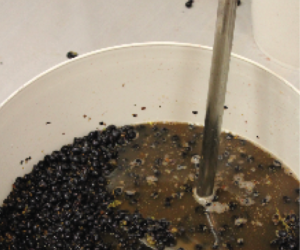
I need help to prevent oxidation. I make about 40 gallons (151 L) from California grapes each year, usually finishing quite nice, but last year’s Sangiovese suffers from oxidation. After fermentation and pressing, the wine spends the next ten to eleven months in carboys fitted with airlocks. I rack at least three times throughout the year by the siphon method. Should I try using carbon dioxide whenever I rack to expel oxygen. Or should I bottle sooner?
Sam Chiodo
via email
I have to commiserate with you on the Sangiovese and oxidation dance. For some reason, this grape varietal seems to be especially prone to color (and related oxidation) issues. Much like Pinot Noir, Sangiovese lacks some of the colored precursors that help a wine age gracefully. Some of the compounds that form high color are, in themselves, antioxidants, which is part of the reason a Cabernet or Petite Sirah (both pretty dark-colored wines) tend to resist the oxidative ravages of time. Therefore, even though Sangiovese grapes normally come in with nice acidity levels (which helps to set and stabilize color too), many Sangioveses will turn what I call “bricky” (brick-red with tinges of orange) before you would expect some other wines to change color.
Let’s address the low-color nature of Sangiovese first. What you can do to help boost the wine’s color is to use a maceration enzyme, which is typically diluted as a 10% solution in water, then added directly to the red grapes before fermentation. Recommended doses differ from product to product, but one I’ve used before has a recommended addition rate of 50–100 mL/ton, or roughly 0.025–0.05 mL/lb of grapes. There are a number of products on the market and I hate to endorse one over the other, so I recommend that you check out the AEB, Scott Labs, American Tartaric Products, Lallemand and Laffort websites and catalogs and look in their enological enzyme section for their color-enhancing enzymes. These enzymes break down cell walls and help liberate both colored and color-precursor components within the grapes, which otherwise might not be released into the fermentation.
During fermentation, make sure that you are doing enough punchdowns or pumpovers to really give the colored components in the skin a chance to extract into the water and alcohol. Just as fermentation is getting going, all you need to do is keep the cap wet to retard the growth of microbes, so maybe one short punchdown in the morning and in the evening. As the Brix start to drop and the fermentation really gets going, I like to make sure I’m doing three or four per day. Back off to two a day as you approach dryness, then one per day just to keep the cap moist towards the end. Studies have shown that doing extended maceration, that is, letting the wine and the skins sit together for days (and sometimes weeks) after alcoholic fermentation has ended may possibly actually decrease color and tannin. In addition, with the higher alcohol levels at the end of fermentation, you also risk increased extraction of bitter seed tannins, which no one wants in their wines. Therefore, I recommend pressing as soon as (or soon thereafter) the wine is dry.
Now, let’s get beyond dealing with Sangiovese-specific concerns and talk about color protection and oxidation protection for all wines. To further protect color as a red wine ages, you need to make sure you aren’t adding too much sulfur dioxide, which can actually have a bleaching effect when used in high doses. For this reason, aim to keep your Free SO2 within the range of 25–30 ppm month to month. Another trick you can try is to add your first SO2 to the wine post ML fermentation in two equal hits as you aim to achieve your final Free SO2 level. My anecdotal experience, and that of others I’ve talked to, seems to bear this method out. However, you want to make sure you’re adding enough SO2 to protect against oxidation. Again, the 25–30 ppm Free SO2 range should be just fine trusting that your pH is under 3.75 or so. As the pH of wine increases (and the acid level decreases), the effectiveness of SO2 decreases, so having enough acid in your wine is important.
One very clear process change you should make right away to avoid oxidation is to change out the airlocks after all your fermentations are complete. Airlocks are there to make sure that gas (CO2) can go out but microbes and air can’t get in. Once you have no more gas that needs to go out (when the primary and MLF fermentations are complete) it’s best to seal your wine up in a more impermeable way, as airlocks are notoriously leaky. Your friendly neighborhood home winemaking supply store (not to mention its electronic counterparts online) sell a plethora of plastic, rubber and cork stoppers that, when used properly, will form a pretty airtight seal. Now, of course air gets into the container every time you open it to adjust your Free SO2 (which you shouldn’t do more than once a month) so keep those rackings, stirrings and tastings (I know, hard to prevent when friends come over) to an intelligent minimum.
Your wine might also benefit from being kept in larger vessels. Follow me here while I give a quick example to illustrate why. Each vessel has an opening, i.e. where you stick the aforesaid stopper. A barrel has a bunghole, a carboy has a mouth and so forth. Each opening, no matter how tightly stoppered, lets in a certain amount of air. So the larger your vessel relative to the size and number of openings (some stainless steel tanks and even barrels have more than one), the more air per volume of wine will get in. This is why wineries bottle up their special reserve wines in magnums (1.5-L) and larger 3-, 5-L and even larger bottles — it’s all about the long-term aging. You say you’re storing 40 gallons (151 L) of Sangiovese in carboys — I assume you are talking about the standard 5-gallon (19-L) carboys, which means that you are currently allowing eight separate opportunities for air ingress. I recommend that you buy a half barrel (about 35 gallons/132 L) and use carboys for topping wine. Fewer weak points in the storage vessels mean happier (and less oxidized) wine over time.
I accidentally made my sulfite solution at 20% (I forgot to top up with cool water when I made the solution) and added double the recommended amount of it to my wine. Is the wine still drinkable?
Cavan Baillie
Renfrew, Ontario
Since I don’t know what your “recommended” number was it’s impossible for me to know what a double addition is in this case. Therefore, you should definitely exercise caution before drinking and if your addition was greater than 50 ppm, I would send a sample out for a lab to check it. The legal limit for Free SO2 on wines in the US is 350 mg/L so if it’s over this level, the government would say a wine is unsaleable.
But what if your levels aren’t nearly that high and you want a ballpark answer about the drinkability of the wine? It’s really a matter of your own taste balanced against the level of the addition you made. If you were doing your monthly SO2 addition with topping, and the wine already had SO2 in it, you were probably trying to add around 10–20 ppm total SO2. If you were to add double that amount, it’s not the end of the world.
If you added twice the SO2 (say, you added 40 ppm total), you probably are OK to drink the wine if you give the wine a little time to absorb that level of SO2. SO2 binds up with sugars, aldehydes and other compounds and I find the “dirtier” (more cloudy, unsettled and turbid) the wine, often the more of the SO2 will bind up and go to Total SO2. The Free SO2 is what you would smell or taste. If your wine is young (especially if it was a highly-colored varietal), chances are good that it will “bounce back” from such a big addition quickly, and would be drinkable within a week or two. If your wine was very clean or almost bottle-ready, that much Free SO2 will generally take longer to bind up so I would give it more time before taking a sip, maybe three or four weeks before checking in.






